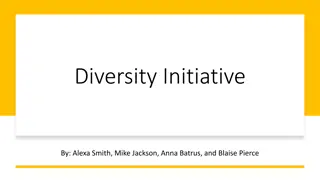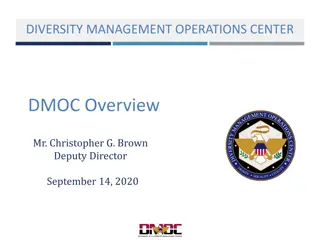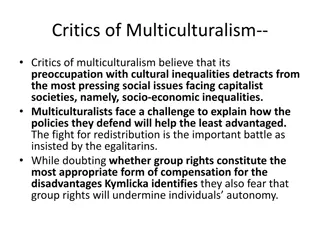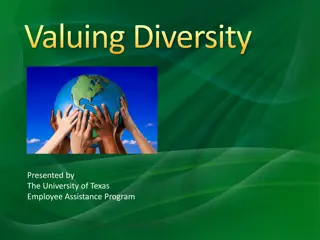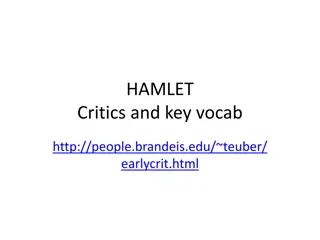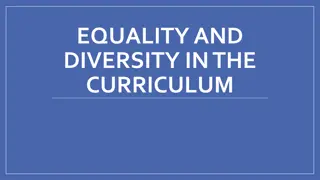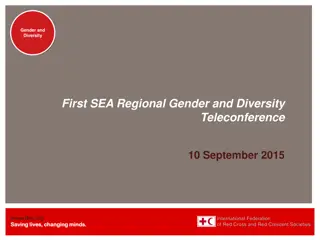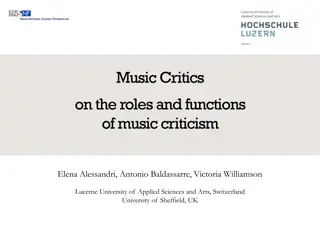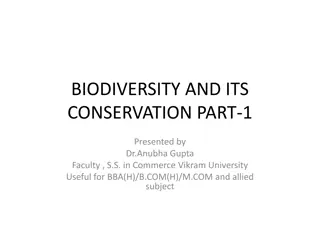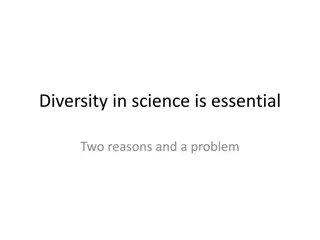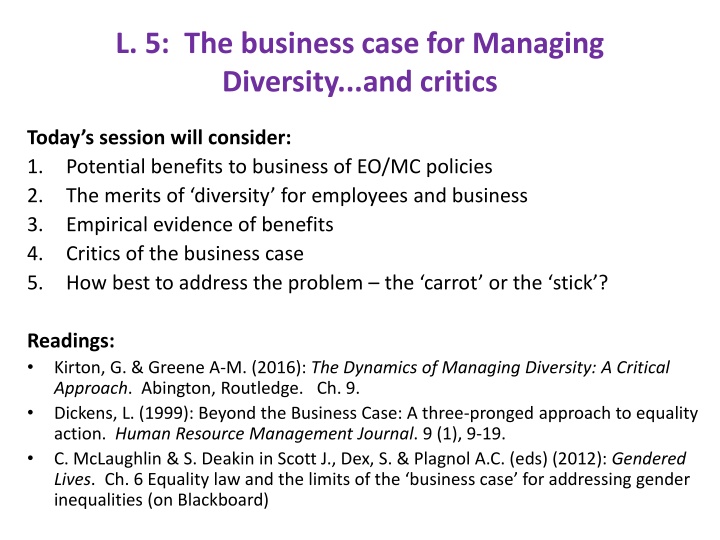
Benefits and Critics of Managing Diversity in Business
Explore the potential benefits of Equal Opportunity/Managing Diversity policies, the advantages of diversity for employees and businesses, empirical evidence supporting diversity, critics of the business case, and strategies to tackle challenges. Readings delve into the dynamics of managing diversity critically, beyond the business case, and equality law implications. Understand how diversity drives business growth by enhancing creativity, innovation, problem-solving, leadership, and global relationships, debunking common diversity myths and highlighting its strategic importance for organizations.
Download Presentation

Please find below an Image/Link to download the presentation.
The content on the website is provided AS IS for your information and personal use only. It may not be sold, licensed, or shared on other websites without obtaining consent from the author. If you encounter any issues during the download, it is possible that the publisher has removed the file from their server.
You are allowed to download the files provided on this website for personal or commercial use, subject to the condition that they are used lawfully. All files are the property of their respective owners.
The content on the website is provided AS IS for your information and personal use only. It may not be sold, licensed, or shared on other websites without obtaining consent from the author.
E N D
Presentation Transcript
L. 5: The business case for Managing Diversity...and critics Today s session will consider: 1. Potential benefits to business of EO/MC policies 2. The merits of diversity for employees and business 3. Empirical evidence of benefits 4. Critics of the business case 5. How best to address the problem the carrot or the stick ? Readings: Kirton, G. & Greene A-M. (2016): The Dynamics of Managing Diversity: A Critical Approach. Abington, Routledge. Ch. 9. Dickens, L. (1999): Beyond the Business Case: A three-pronged approach to equality action. Human Resource Management Journal. 9 (1), 9-19. C. McLaughlin & S. Deakin in Scott J., Dex, S. & Plagnol A.C. (eds) (2012): Gendered Lives. Ch. 6 Equality law and the limits of the business case for addressing gender inequalities (on Blackboard)
Managing Diversity Building an inclusive work environment that allows everyone to reach their potential
What is the Business Case? A structured proposal for business change Justified in terms of costs and benefits Addresses the business need that the project seeks to resolve reasons for the project expected business benefits the options considered expected costs of the project a gap analysis expected risks
Ways in which diversity drives business growth Improves marketplace understanding Enhances creativity and innovation Produces higher quality of team problem-solving Enhances leadership effectiveness Builds effective global relationships Provides better utilization of talent
Diversity - Myths vs. Realities Diversity is a problem, NO its an opportunity Diversity is the HR Departments responsibility , NO its our responsibility Diversity is about just race and gender, NO because managing diversity is much broader and pervasive than just race and gender. Diversity is only about minorities and women in the workplace, NO its about recognizing the diversity of your internal(employees)and external customers to compete in a diverse market, both nationally and globally.
Diversity - myths vs. realities cont. Diversity is about exclusivity, NO its about inclusivity and maximizing everyone`s talents and contributions for organizations to gain a competitive human resource advantage. Diversity is just another fad, NO because the national and demographic workplace trends prove its here to stay. The real question is whether you can manage it as a positive rather than a negative force for change in your organization. Diversity is just another form of EEO/AAP, NO because Diversity goes beyond compliance as an organizational commitment to excellence, by using diversity as a source of strength.
Research on the effect of managing diversity Improved performance/productivity (Agocs and Burr, 1996; Richard, 2000) Increased creativity/flexibility (Cox and Blake, 1991; Robinson and Dechant, 1997) Higher quality of problem-solving (Cox and Blake, 1991; Hubbard, 1999) Improved understanding/penetration of markets (Cox and Blake, 1991; Robinson and Dechant, 1997). Increased staff morale and job satisfaction (Agocs and Burr, 1996) Improvements in staff retention, less absenteeism (Agocs and Burr, 1996; Robinson and Dechant, 1997) Less law suits (Robinson and Dechant, 1997)
The Business Case For Diversity Arguments in the Business Case for Diversity Cultural diversity builds strength for dealing with global markets. Ethnic diversity builds strength for dealing with diverse customers. Legal compliance Diverse work teams are high in creativity and innovation. Efficiency in Human Resource Management/Talents (Monks & Barker) Better industrial relations Positive company image To be successful in working with and gaining value from diversity requires a sustained, systemic approach and long-term commitment. Success is facilitated by a perspective that considers diversity to be an opportunity for everyone in an organization to learn from each other how better to accomplish their work and an occasion that requires a supportive and cooperative organizational culture as well as group leadership and process skills that can facilitate effective group functioning.
Organisations and diversity mission statements Example Coca-Cola The Coca-Cola Company's global diversity mission is to mirror the rich diversity of the marketplace we serve and be recognized for our leadership in Diversity, Inclusion and Fairness in all aspects of our business, including Workplace, Marketplace, Supplier and Community, enhancing the Company s social license to operate.
Creating A Culture of Belonging, Inclusion and Diversity At the heart of our business, we seek to inspire and nurture the human spirit - understanding that each person brings a distinct life experience to the table. Our partners are diverse not only in gender, race, ethnicity, sexual orientation, disability, religion and age, but also in cultural backgrounds, life experiences, thoughts and ideas. Embracing diversity only enhances our work culture, it also drives our business success. It is the inclusion of these diverse experiences and perspectives that create a culture of empowerment, one that fosters innovation, economic growth and new ideas.
The Business Case some evidence (CIPD report) ORGANISATION OAG Nationwide Building Society COMPAQ computers Barclays Bank PRACTICE On-site day care centre Work-Life balance Telecommuting Removal of age barriers BENEFITS Post-maternity turnover reduced from 23% to 12% 14% employee satisfaction rise; return to work post- maternity 93% Selling six times more computers as under previous system. Reduced training costs, Improved retention. Survey of 200 companies in four EU states identified link between organisational commitment to diversity policy and perceptions of business improvements. Financial and non-financial benefits e.g. improved communications, solving of skill shortages.
The Business Case The business case is the return on investment (ROI) in terms of performance and economic outcomes that results from leveraging the variant knowledge, skills, abilities, talents, intellectual capital, perspectives, working styles, etc. of a diverse workforce.
The Broadening Business Case More recently the business case has broadened. Depending on the particularities of their business environment, strategic priorities, stakeholder expectations, regulatory concerns and the nature of their value chain, organisations adopt a particular focus for crafting their business case arguments: shareholder value: profitability, return on investment stakeholder value: profits, people, planet regulatory context: self-regulation, sectoral, legal and economic regulation global value chain: transnational parity and responsible globalisation.
Evidence of Benefits of the Business case Monks/NCPP/Equality Authority report. International Research evidence to indicate: a) positive relationship between equality/diversity policies and organisational performance (e.g. reduced labour shortages/retention; broader decision making base/greater access to diverse markets; reduced litigation). b) positive relationship between equality policies and employee benefits (e.g. job satisfaction, reduced stress, work-life balance) leading to positive employee performance (e.g. reduced turnover; greater innovation and creativity).
Monks (2007) states that there is a need for Ireland to grow more high paid jobs and knowledge intensive investment and she comments on the under-utilisation of skills and knowledge if all migrant workers were employed at a level reflecting their standard of education, it would contribute around 3.5 percent to the country s GNP . (p.17).
There are problems re take up of some policies (e.g. flexible working). Problems of culture of presenteeism ; fear of reduced career opportunities. See critical success factors (Monks) eg. Need for training (e.g. awareness, skills) Need for support from top management; Need for measurement of impact; Need for full integration and incorporation of equality/diversity policies into organisation s vision, core values (mainstreaming). No quick fix !!
The Costs of Not Managing Diversity The Real Thing -Coca-Cola agrees to pay $192.5 Million, and make HR policy changes to settle suit (Race), 11/16/00 California Bakery Workers Awarded $120 Million on Race Bias Claims, 8/2/00 First Union Bank Corp. agreed to pay $58.5 million to 239 employees at two banks it acquired in 1992-93(settlement date, Oct., 1997)-age discrimination
The Social Justice Case Promoting and supporting diversity in the workplace is an important aspect of good people management - it s about valuing everyone in the organisation as an individual. There is a strong moral case for organisations to excel in their equality and diversity practices. An inclusive work environment where everyone is treated with dignity and respect would demonstrate the organisations s social and moral responsibility from a basis of shared values.
Excellence in diversity gives organisations the means to meet and exceed social obligations. Meeting these demands will not only benefit organisations but will also help develop greater social cohesion, tolerance, stability and prosperity in the wider society. One thing that unites many organisations is that they take pride and publicise themselves on the basis that they want to make their workplaces a better place for everyone to work in, thus employees cannot be treated unfairly because of their race, gender, sexual orientation, age, religion or belief, or disability.
Critics of the Business Case Some critics of the business case argue that the social justice case should be paramount. The value-in-diversity perspective argues that a diverse workforce, relative to a homogeneous one, is generally beneficial for business, including but not limited to corporate profits and earnings. This is in contrast to other accounts that view diversity as either nonconsequential to business success or actually detrimental by creating conflict, undermining cohesion, and thus decreasing productivity.
Where managing diversity or parts of managing diversity - is either nonconsequential to business success or actually detrimental to success then organisations may not engage with and thus they may cherry-pick which elements of managing diversity to engage with. Where managing diversity is beneficial for business, then surely they would do that anyway isn t that just good management; why are we calling it managing diversity?
Business Case Critics (Dickens, M. Noon, Kirton and Greene) Reliance on business case arose in the context of hostile conservative policy of the 1980 s Appeal of business case varies over time/economic climate/needs of industry The business case may be counter to equal opportunities agenda It may be damaging to social justice depoliticising equality (Noon) and thus taking the issue off the agenda
Dickens three-pronged approach to equal opportunities draws upon: The business case broadly defined e.g. corporate responsibility Legal regulation (national and EU) Social regulation (equality bargaining/partnership at EU, national or local level).


